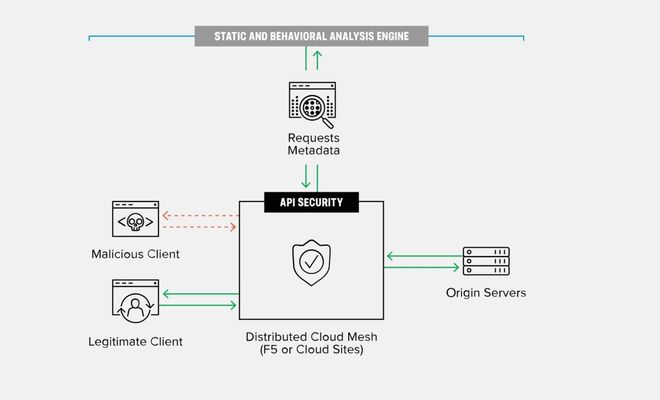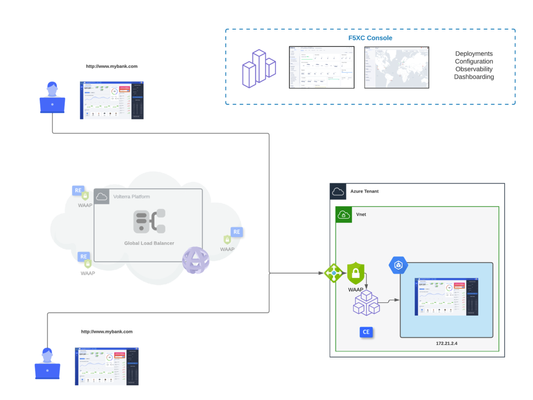F5 Distributed Cloud WAAP
79 TopicsF5 Distributed Cloud Bot Defense (Overview and Demo)
What is Distributed Cloud Bot Defense? Distributed Cloud Bot Defense protects your web properties from automated attacks by identifying and mitigating malicious bots. Bot Defense uses JavaScript and API calls to collect telemetry and mitigate malicious users within the context of the Distributed Cloud global network. Bot Defense can easily be integrated into existing applications in a number of ways. For applications already routing traffic through Distributed Cloud Mesh Service, Bot Defense is natively integrated into your Distributed Cloud Mesh HTTP load balancers. This integration allows you to configure the Bot Defense service through the HTTP load balancer's configuration in the Distributed Cloud Console. For other applications, connectors are available for several common insertion points that likely already exist in modern application architectures. Once Bot Defense is enabled and configured, you can view and filter traffic and transaction statistics on the Bot Defense dashboard in Distributed Cloud Console to see which users are malicious and how they’re being mitigated. F5 Distributed Cloud Bot Defense is an advanced add-on security feature included in the first launch of the F5 Web Application and API Protection (WAAP) service with seamless integration to protect your web apps and APIs from a wide variety of attacks in real-time. High Level Distributed Cloud Security Architecture Bot Defense Demo: In this technical demonstration video we will walk through F5 Distributed Cloud Bot Defense, showing you how quick and easy it is to configure, the insights and visibility you have while demonstrating a couple of real attacks with Selenium and Python browser automation. "Nature is a mutable cloud, which is always and never the same." - Ralph Waldo Emerson We might not wax that philosophically around here, but our heads are in the cloud nonetheless! Join the F5 Distributed Cloud user group today and learn more with your peers and other F5 experts. Hope you enjoyed this Distributed Cloud Bot Defense Overview and Demo. If there are any comments or questions please feel free to reach us in the comments section. Thanks! Related Resources: Deploy Bot Defense on any Edge with F5 Distributed Cloud (SaaS Console, Automation) Protecting Your Web Applications Against Critical OWASP Automated Threats Making Mobile SDK Integration Ridiculously Easy with F5 XC Mobile SDK Integrator JavaScript Supply Chains, Magecart, and F5 XC Client-Side Defense (Demo) Bots, Fraud, and the OWASP Automated Threats Project (Overview) Protecting Your Native Mobile Apps with F5 XC Mobile App Shield Enabling F5 Distributed Cloud Client-Side Defense in BIG-IP 17.1 Bot Defense for Mobile Apps in XC WAAP Part 1: The Bot Defense Mobile SDK F5 Distributed Cloud WAAP Distributed Cloud Services Overview Enable and Configure Bot Defense - F5 Distributed Cloud Service8.7KViews2likes0CommentsUse F5 Distributed Cloud to service chain WAAP and CDN
The Content Delivery Network (CDN) market has become increasingly commoditized. Many providers have augmented their CDN capabilities with WAFs/WAAPs, DNS, load balancing, edge compute, and networking. Managing all these solutions together creates a web of operational complexity, which can be confusing. F5’s synergistic bundling of CDN with Web Application and API Protection (WAAP) benefits those looking for simplicity and ease of use. It provides a way around the complications and silos that many resource-strapped organizations face with their IT systems. This bundling also signifies how CDN has become a commodity product often not purchased independently anymore. This trend is encouraging many competitors to evolve their capabilities to include edge computing – a space where F5 has gained considerable experience in recent years. F5 is rapidly catching up to other providers’ CDNs. F5’s experience and leadership building the world’s best-of-breed Application Delivery Controller (ADC), the BIG-IP load balancer, put it in a unique position to offer the best application delivery and security services directly at the edge with many of its CDN points of presence. With robust regional edge capabilities and a global network, F5 has entered the CDN space with a complementary offering to an already compelling suite of features. This includes the ability to run microservices and Kubernetes workloads anywhere, with a complete range of services to support app infrastructure deployment, scale, and lifecycle management all within a single management console. With advancements made in the application security space at F5, WAAP capabilities are directly integrated into the Distributed Cloud Platform to protect both web apps and APIs. Features include (yet not limited to): Web Application Firewall: Signature + Behavioral WAF functionality Bot Defense: Detect client signals, determining if clients are human or automated DDoS Mitigation: Fully managed by F5 API Security: Continuous inspection and detection of shadow APIs Solution Combining the Distributed Cloud WAAP with CDN as a form of service chaining is a straightforward process. This not only gives you the best security protection for web apps and APIs, but also positions apps regionally to deliver them with low latency and minimal compute per request. In the following solution, we’ve combined Distributed Cloud WAAP and CDN to globally deliver an app protected by a WAF policy from the closest regional point of presence to the user. Follow along as I demonstrate how to configure the basic elements. Configuration Log in to the Distributed Cloud Console and navigate to the DNS Management service. Decide if you want Distributed Cloud to manage the DNS zone as a Primary DNS server or if you’d rather delegate the fully qualified domain name (FQDN) for your app to Distributed Cloud with a CNAME. While using Delegation or Managed DNS is optional, doing so makes it possible for Distributed Cloud to automatically create and manage the SSL certificates needed to securely publish your app. Next, in Distributed Cloud Console, navigate to the Web App and API Protection service, then go to App Firewall, then Add App Firewall. This is where you’ll create the security policy that we’ll later connect our HTTP LB. Let’s use the following basic WAF policy in YAML format, you can paste it directly in to the Console by changing the configuration view to JSON and then changing the format to YAML. Note: This uses the namespace “waap-cdn”, change this to match your individual tenant’s configuration. metadata: name: buytime-waf namespace: waap-cdn labels: {} annotations: {} disable: false spec: blocking: {} detection_settings: signature_selection_setting: default_attack_type_settings: {} high_medium_low_accuracy_signatures: {} enable_suppression: {} enable_threat_campaigns: {} default_violation_settings: {} bot_protection_setting: malicious_bot_action: BLOCK suspicious_bot_action: REPORT good_bot_action: REPORT allow_all_response_codes: {} default_anonymization: {} use_default_blocking_page: {} With the WAF policy saved, it’s time to configure the origin server. Navigate to Load Balancers > Origin Pools, then Add Origin Pool. The following YAML uses a FQDN DNS name reach the app server. Using an IP address for the server is possible as well. metadata: name: buytime-pool namespace: waap-cdn labels: {} annotations: {} disable: false spec: origin_servers: - public_name: dns_name: webserver.f5-cloud-demo.com labels: {} no_tls: {} port: 80 same_as_endpoint_port: {} healthcheck: [] loadbalancer_algorithm: LB_OVERRIDE endpoint_selection: LOCAL_PREFERRED With the supporting WAF and Origin Pool resources configured, it’s time to create the HTTP Load Balancer. Navigate to Load Balancers > HTTP Load Balancers, then create a new one. Use the following YAML to create the LB and use both resources created above. metadata: name: buytime-online namespace: waap-cdn labels: {} annotations: {} disable: false spec: domains: - buytime.waap.f5-cloud-demo.com https_auto_cert: http_redirect: true add_hsts: true port: 443 tls_config: default_security: {} no_mtls: {} default_header: {} enable_path_normalize: {} non_default_loadbalancer: {} header_transformation_type: default_header_transformation: {} advertise_on_public_default_vip: {} default_route_pools: - pool: tenant: your-tenant-uid namespace: waap-cdn name: buytime-pool kind: origin_pool weight: 1 priority: 1 endpoint_subsets: {} routes: [] app_firewall: tenant: your-tenant-uid namespace: waap-cdn name: buytime-waf kind: app_firewall add_location: true no_challenge: {} user_id_client_ip: {} disable_rate_limit: {} waf_exclusion_rules: [] data_guard_rules: [] blocked_clients: [] trusted_clients: [] ddos_mitigation_rules: [] service_policies_from_namespace: {} round_robin: {} disable_trust_client_ip_headers: {} disable_ddos_detection: {} disable_malicious_user_detection: {} disable_api_discovery: {} disable_bot_defense: {} disable_api_definition: {} disable_ip_reputation: {} disable_client_side_defense: {} resource_version: "517528014" With the HTTP LB successfully deployed, check that its status is ready on the status page. You can verify the LB is working by sending a basic request using the command line tool, curl. Confirm that the value of the HTTP header “Server” is “volt-adc”. da.potter@lab ~ % curl -I https://buytime.waap.f5-cloud-demo.com HTTP/2 200 date: Mon, 17 Oct 2022 23:23:55 GMT content-type: text/html; charset=UTF-8 content-length: 2200 vary: Origin access-control-allow-credentials: true accept-ranges: bytes cache-control: public, max-age=0 last-modified: Wed, 24 Feb 2021 11:06:36 GMT etag: W/"898-177d3b82260" x-envoy-upstream-service-time: 136 strict-transport-security: max-age=31536000 set-cookie: 1f945=1666049035840-557942247; Path=/; Domain=f5-cloud-demo.com; Expires=Sun, 17 Oct 2032 23:23:55 GMT set-cookie: 1f9403=viJrSNaAp766P6p6EKZK7nyhofjXCVawnskkzsrMBUZIoNQOEUqXFkyymBAGlYPNQXOUBOOYKFfs0ne+fKAT/ozN5PM4S5hmAIiHQ7JAh48P4AP47wwPqdvC22MSsSejQ0upD9oEhkQEeTG1Iro1N9sLh+w+CtFS7WiXmmJFV9FAl3E2; path=/ x-volterra-location: wes-sea server: volt-adc Now it’s time to configure the CDN Distribution and service chain it to the WAAP HTTP LB. Navigate to Content Delivery Network > Distributions, then Add Distribution. The following YAML creates a basic CDN configuration that uses the WAAP HTTP LB above. metadata: name: buytime-cdn namespace: waap-cdn labels: {} annotations: {} disable: false spec: domains: - buytime.f5-cloud-demo.com https_auto_cert: http_redirect: true add_hsts: true tls_config: tls_12_plus: {} add_location: false more_option: cache_ttl_options: cache_ttl_override: 1m origin_pool: public_name: dns_name: buytime.waap.f5-cloud-demo.com use_tls: use_host_header_as_sni: {} tls_config: default_security: {} volterra_trusted_ca: {} no_mtls: {} origin_servers: - public_name: dns_name: buytime.waap.f5-cloud-demo.com follow_origin_redirect: false resource_version: "518473853" After saving the configuration, verify that the status is “Active”. You can confirm the CDN deployment status for each individual region by going to the distribution’s action button “Show Global Status”, and scrolling down to each region to see that each region’s “site_status.status” value is “DEPLOYMENT_STATUS_DEPLOYED”. Verification With the CDN Distribution successfully deployed, it’s possible to confirm with the following basic request using curl. Take note of the two HTTP headers “Server” and “x-cache-status”. The Server value will now be “volt-cdn”, and the x-cache-status will be “MISS” for the first request. da.potter@lab ~ % curl -I https://buytime.f5-cloud-demo.com HTTP/2 200 date: Mon, 17 Oct 2022 23:24:04 GMT content-type: text/html; charset=UTF-8 content-length: 2200 vary: Origin access-control-allow-credentials: true accept-ranges: bytes cache-control: public, max-age=0 last-modified: Wed, 24 Feb 2021 11:06:36 GMT etag: W/"898-177d3b82260" x-envoy-upstream-service-time: 63 strict-transport-security: max-age=31536000 set-cookie: 1f945=1666049044863-471593352; Path=/; Domain=f5-cloud-demo.com; Expires=Sun, 17 Oct 2032 23:24:04 GMT set-cookie: 1f9403=aCNN1JINHqvWPwkVT5OH3c+OIl6+Ve9Xkjx/zfWxz5AaG24IkeYqZ+y6tQqE9CiFkNk+cnU7NP0EYtgGnxV0dLzuo3yHRi3dzVLT7PEUHpYA2YSXbHY6yTijHbj/rSafchaEEnzegqngS4dBwfe56pBZt52MMWsUU9x3P4yMzeeonxcr; path=/ x-volterra-location: dal3-dal server: volt-cdn x-cache-status: MISS strict-transport-security: max-age=31536000 To see a security violation detected by the WAF in real-time, you can simulate a simple XSS exploit with the following curl: da.potter@lab ~ % curl -Gv "https://buytime.f5-cloud-demo.com?<script>('alert:XSS')</script>" * Trying x.x.x.x:443... * Connected to buytime.f5-cloud-demo.com (x.x.x.x) port 443 (#0) * ALPN, offering h2 * ALPN, offering http/1.1 * successfully set certificate verify locations: * CAfile: /etc/ssl/cert.pem * CApath: none * (304) (OUT), TLS handshake, Client hello (1): * (304) (IN), TLS handshake, Server hello (2): * TLSv1.2 (IN), TLS handshake, Certificate (11): * TLSv1.2 (IN), TLS handshake, Server key exchange (12): * TLSv1.2 (IN), TLS handshake, Server finished (14): * TLSv1.2 (OUT), TLS handshake, Client key exchange (16): * TLSv1.2 (OUT), TLS change cipher, Change cipher spec (1): * TLSv1.2 (OUT), TLS handshake, Finished (20): * TLSv1.2 (IN), TLS change cipher, Change cipher spec (1): * TLSv1.2 (IN), TLS handshake, Finished (20): * SSL connection using TLSv1.2 / ECDHE-ECDSA-AES256-GCM-SHA384 * ALPN, server accepted to use h2 * Server certificate: * subject: CN=buytime.f5-cloud-demo.com * start date: Oct 14 23:51:02 2022 GMT * expire date: Jan 12 23:51:01 2023 GMT * subjectAltName: host "buytime.f5-cloud-demo.com" matched cert's "buytime.f5-cloud-demo.com" * issuer: C=US; O=Let's Encrypt; CN=R3 * SSL certificate verify ok. * Using HTTP2, server supports multiplexing * Connection state changed (HTTP/2 confirmed) * Copying HTTP/2 data in stream buffer to connection buffer after upgrade: len=0 * Using Stream ID: 1 (easy handle 0x14f010000) > GET /?<script>('alert:XSS')</script> HTTP/2 > Host: buytime.f5-cloud-demo.com > user-agent: curl/7.79.1 > accept: */* > * Connection state changed (MAX_CONCURRENT_STREAMS == 128)! < HTTP/2 200 < date: Sat, 22 Oct 2022 01:04:39 GMT < content-type: text/html; charset=UTF-8 < content-length: 269 < cache-control: no-cache < pragma: no-cache < set-cookie: 1f945=1666400679155-452898837; Path=/; Domain=f5-cloud-demo.com; Expires=Fri, 22 Oct 2032 01:04:39 GMT < set-cookie: 1f9403=/1b+W13c7xNShbbe6zE3KKUDNPCGbxRMVhI64uZny+HFXxpkJMsCKmDWaihBD4KWm82reTlVsS8MumTYQW6ktFQqXeFvrMDFMSKdNSAbVT+IqQfSuVfVRfrtgRkvgzbDEX9TUIhp3xJV3R1jdbUuAAaj9Dhgdsven8FlCaADENYuIlBE; path=/ < x-volterra-location: dal3-dal < server: volt-cdn < x-cache-status: MISS < strict-transport-security: max-age=31536000 < <html><head><title>Request Rejected</title></head> <body>The requested URL was rejected. Please consult with your administrator.<br/><br/> Your support ID is 85281693-eb72-4891-9099-928ffe00869c<br/><br/><a href='javascript:history.back();'>[Go Back]</a></body></html> * Connection #0 to host buytime.f5-cloud-demo.com left intact Notice that the above request intentionally by-passes the CDN cache and is sent to the HTTP LB for the WAF policy to inspect. With this request rejected, you can confirm the attack by navigating to the WAAP HTTP LB Security page under the WAAP Security section within Apps & APIs. After refreshing the page, you’ll see the security violation under the “Top Attacked” panel. Demo To see all of this in action, watch my video below. This uses all of the configuration details above to make a WAAP + CDN service chain in Distributed Cloud. Additional Guides Virtually deploy this solution in our product simulator, or hands-on with step-by-step comprehensive demo guide. The demo guide includes all the steps, including those that are needed prior to deployment, so that once deployed, the solution works end-to-end without any tweaks to local DNS. The demo guide steps can also be automated with Ansible, in case you'd either like to replicate it or simply want to jump to the end and work your way back. Conclusion This shows just how simple it can be to use the Distributed Cloud CDN to frontend your web app protected by a WAF, all natively within the F5 Distributed Cloud’s regional edge POPs. The advantage of this solution should now be clear – the Distributed Cloud CDN is cloud-agnostic, flexible, agile, and you can enforce security policies anywhere, regardless of whether your web app lives on-prem, in and across clouds, or even at the edge. For more information about Distributed Cloud WAAP and Distributed Cloud CDN, visit the following resources: Product website: https://www.f5.com/cloud/products/cdn Distributed Cloud CDN & WAAP Demo Guide: https://github.com/f5devcentral/xcwaapcdnguide Video: https://youtu.be/OUD8R6j5Q8o Simulator: https://simulator.f5.com/s/waap-cdn Demo Guide: https://github.com/f5devcentral/xcwaapcdnguide8.1KViews10likes0CommentsIntroduction to OWASP API Security Top 10 2023
Introduction to API An Application Programming Interface (API) is a component that enables communication between two different systems by following certain rules. It also adds a layer of abstraction between the two systems where the requester does not know how the other system has derived the result and responded back. Over the past few years, developers have started relying more on APIs as it helps them to meet the needs of today’s rapid application deployment model. As the APIs started getting a wider acceptance it is highly critical to safeguard them by thoroughly testing their behavior and following best security practices. Learn API Security Best Practices. Overview of OWASP API Security The OWASP API Security project aims to help the organizations by providing a guide with a list of the latest top 10 most critical API vulnerabilities and steps to mitigate them. As part of updating the old OWASP API Security risk categories of 2019, recently OWASP API Security Top 10 2023 is released. What’s new in OWASP API Sec 2023? List of vulnerabilities: API1:2023 Broken Object Level Authorization Broken Object Level Authorization (BOLA) is a vulnerability that occurs when there is a failure in validation of user’s permissions to perform a specific task over an object which may eventually lead to leakage, updation or destruction of data. To prevent this vulnerability, proper authorization mechanism should be followed, proper checks should be made to validate user’s action on a certain record and security tests should be performed before deploying any production grade changes. API2:2023 Broken Authentication Broken Authentication is a critical vulnerability that occurs when application’s authentication endpoints fail to detect attackers impersonating someone else’s identity and allow partial or full control over the account. To prevent this vulnerability, observability and understanding of all possible authentication API endpoints is needed, re-authentication should be performed for any confidential changes, multi-factor authentication, captcha-challenge and effective security solutions should be applied to detect & mitigate credential stuffing, dictionary and brute force type of attacks. API3:2023 Broken Object Property Level Authorization Broken Object Property Level Authorization (Excessive Data Exposure, Mass Assignment) is one of the new risk categories of OWASP API Security Top 10 2023. This vulnerability occurs when a user is allowed to access an object’s property without validating his access permissions. Excessive Data Exposure and Mass Assignment which were initially a part of OWASP APISec 2019 are now part of this new vulnerability. To prevent this vulnerability, access privileges of users requesting for a specific object's property should be scrutinized before exposure by the API endpoints. Use of generic methods & automatically binding client inputs to internal objects or code variables should be avoided and schema-based validation should be enforced. API4:2023 Unrestricted Resource Consumption Unrestricted Resource Consumption vulnerability occurs when the system’s resources are being unnecessarily consumed which could eventually lead to degradation of services and performance latency issues. Although the name has changed, the vulnerability is still the same as that of Lack of Resources & Rate Limiting. To prevent this vulnerability, rate-limiting, maximum size for input payload/parameters and server-side validations of requests should be enforced. API5:2023 Broken Function Level Authorization Broken Function Level Authorization occurs when vulnerable API endpoints allow normal users to perform administrative actions or user from one group is allowed to access a function specific to users of another group. To prevent this vulnerability, access control policies and administrative authorization checks based on user’s group/roles should be implemented. API6:2023 Unrestricted Access to Sensitive Business Flows Unrestricted Access to Sensitive Business Flows is also a new addition to the list of API vulnerabilities. While writing API endpoints it is extremely critical for the developers to have a clear understanding of the business flows getting exposed by it. To avoid exposing any sensitive business flow and limit its excessive usage which if not considered, might eventually lead to exploitation by the attackers and cause some serious harm to the business. This also includes securing and limiting access to B2B APIs that are consumed directly and often integrated with minimal protection mechanism. By keeping automation to work, now-a-days attackers can bypass traditional protection mechanisms. APIs inefficiency in detecting automated bot attacks not only causes business loss but also it can adversely impact the services for real users as well. To overcome this vulnerability, enterprises need to have a platform to identify whether the request is from a real user or an automated tool by analyzing and tracking patterns of usage. Device fingerprinting, Integrating Captcha solution, blocking Tor requests, are a few methods which can help to minimize the impact of such automated attacks. For more details on automated threats, you can visit OWASP Automated Threats to Web Applications Note: Although the vulnerability is new but it contains some references of API10:2019 Insufficient Logging & Monitoring API7:2023 Server-Side Request Forgery After finding a place in OWASP Top 10 web application vulnerabilities of 2021, SSRF has now been included in OWASP API Security Top 10 2023 list as well, showing the severity of this vulnerability. Server-Side Request Forgery (SSRF) vulnerability occurs when an API fetches an internal server resource without validating the URL from the user. Attackers exploit this vulnerability by manipulating the URL, which in turn helps them to retrieve sensitive data from the internal servers. To overcome this vulnerability, Input data validations should be implemented to ensure that the client supplied input data obeys the expected format. Allow lists should be maintained so that only trusted requests/calls will be processed, and HTTP redirections should be disabled. API8:2023 Security Misconfiguration Security Misconfiguration is a vulnerability that may arise when security best practices are overlooked. Unwanted exposure of debug logs, unnecessary enabled HTTP Verbs, unapplied latest security patches, missing repeatable security hardening process, improper implementation of CORS policy etc. are a few examples of security misconfiguration. To prevent this vulnerability, systems and entire API stack should be maintained up to date without missing any security patches. Continuous security hardening and configurations tracking process should be carried out. Make sure all API communications take place over a secure channel (TLS) and all servers in HTTP server chain process incoming requests. Cross-Origin Resource Sharing (CORS) policy should be set up properly. Unnecessary HTTP verbs should be disabled. API9:2023 Improper Inventory Management Improper Inventory Management vulnerability occurs when organizations don’t have much clarity on their own APIs as well as third-party APIs that they use and lack proper documentation. Unawareness with regards to current API version, environment, access control policies, data shared with the third-party etc. can lead to serious business repercussions. Clear understanding and proper documentation are the key to overcome this vulnerability. All the details related to API hosts, API environment, Network access, API version, Integrated services, redirections, rate limiting, CORS policy should be documented correctly and maintained up to date. Documenting every minor detail is advisable and authorized access should be given to these documents. Exposed API versions should be secured along with the production version. A risk analysis is recommended whenever newer versions of APIs are available. API10:2023 Unsafe Consumption of APIs Unsafe Consumption of APIs is again a newly added vulnerability covering a portion of API8:2019 Injection vulnerability. This occurs when developers tend to apply very little or no sanitization on the data received from third-party APIs. To overcome this, we should make sure that API interactions take place over an encrypted channel. API data evaluation and sanitization should be carried out before using the data further. Precautionary actions should be taken to avoid unnecessary redirections by using Allow lists. How F5 XC can help? F5 Distributed Cloud (F5 XC) has a wide range of solutions for deploying, managing and securing application deployments in different environments. XC WAAP is a F5 SaaS offering. The 4 key components of WAAP are Web Application Firewall, API Security, Bot Defense, DDoS Mitigation. All these solutions are powered on top of the XC platform. In addition to WAAP, F5 XC has other solutions to offer such as Fraud and Abuse, AIP, CDN, MCN, DNS and so on. API security in XC WAAP simplifies operations with automated discovery of API transactions using AI/ML Engine along with insights of performance. It also provides API protection features like Rate Limiting, PII safeguard along with comprehensive security monitoring GUI dashboard. API security provides feasibility to import the inventory file in the form of swagger which helps to know exactly what endpoints, methods and payloads are valid, and this tightens security against abuse. F5 XC management console helps the customers to leverage the benefit of monitoring, managing, and maintaining their application’s traffic from a single place irrespective of its platform on which it is hosted, it could be multi-cloud, on prem or edge. Note: This is an initial article covering the overview of proposed most critical API vulnerabilities from OWASP API Security community for 2023. More articles covering detailed insight of each vulnerability and their mitigation steps using F5 XC platform will follow this article in coming days. Meanwhile, you can refer to overview article for OWASP API Security Top 10 2019 which contains link to detailed articles covering API vulnerabilities of 2019 and how F5 XC can help to mitigate them. Related OWASP API Security article series: Broken Authentication Excessive Data Exposure Mass Assignment Lack of Resources & Rate limiting Security Misconfiguration Improper Assets Management Unsafe consumption of APIs Server-Side Request Forgery Unrestricted Access to Sensitive Business Flows OWASP API Security Top 10 - 20197.7KViews5likes1CommentIntroduction to OWASP Top 10 API Security Risks - 2019 and F5 Distributed Cloud WAAP
Introduction to API: An application programming interface (API) is a combination of protocols, functions, etc. which we can utilize to get details about resources, services and features. APIs are fast, lightweight and reliable but they expose sensitive data and so they have become the targets of hackers. Overview of OWASP API Security: The simplicity of APIs has given hackers a chance to infiltrate them in plethora of ways to steal personal and sensitive details. Increase in demand of API security caused a need for a project to keep track of latest API vulnerabilities and security procedures called OWASP API Security Top 10. As per the above project below are the top ten issues and their overview in API security as of 2019. API1:2019 Broken Object Level Authorization APIs expose endpoints that manage objects using unique identifiers, providing hackers a chance to bypass access controls. To prevent this attacks authorized checks like credentials and API token should always be kept in place in the code if there is a request using a user input. API2:2019 Broken User Authentication Authentication mechanisms are sometimes implemented with less security, allowing attackers to compromise authentication tokens to take over other user's identities. For more information about this vulnerability, demonstration scenario and prevention steps using F5 XC refer to the article. API3:2019 Excessive Data Exposure In most of the recent attacks it was observed developers are exposing unnecessary and sensitive object properties providing illegal users a way to exploit them. For more information about this vulnerability, demonstration scenario and prevention steps using F5 XC refer to the article. API4:2019 Lack of Resources & Rate Limiting APIs do not have any restrictions on the size or number of resources that can be requested by the end user. Above mentioned scenarios sometimes lead to poor API server performance, Denial of Service (DoS) and brute force attacks. For more information about this vulnerability, demonstration scenario and prevention steps using F5 XC refer to the article. API5:2019 Broken Function Level Authorization Most applications are composed of different groups, users and roles. If configurations like access control are not applied, it will lead to authorization flaws allowing one user to access the resources of other users. API6:2019 Mass Assignment Code sanity should always be performed in response data, binding client data into code variables without filtering gives hackers a chance to guess object's properties by exploring the API endpoints, documentations, etc. For more information about this vulnerability, demonstration scenario and prevention steps using F5 XC refer to the article. API7:2019 Security Misconfiguration This attack is mostly caused because of misconfigured HTTP headers, unnecessary HTTP methods, permissive Cross-Origin resource sharing (CORS), and verbose error messages in logs containing sensitive information like usernames, PIN, IP addresses, etc. For more information about this vulnerability, demonstration scenario and prevention steps using F5 XC refer to the article. API8:2019 Injection OS commands, SQL, Command Injection, etc., occur if there are no restrictions on user requested schema as part of filter query. The malicious request can sometimes bypass these validations to execute unintended commands providing attackers access to sensitive information. For more information about this vulnerability, demonstration scenario and prevention steps using F5 XC refer to the article. API9:2019 Improper Assets Management A modern web application typically hosts thousands of requests. It is critical to update the documentation/swagger as per the latest changes and include information about newly implemented APIs. If they are not regularly updated hackers can explore and find any deprecated API which may sometimes expose debug endpoints. For more information about this vulnerability, demonstration scenario and prevention steps using F5 XC refer to the article. API10:2019 Insufficient Logging & Monitoring Any issues in logging and monitoring services will give attackers more ways to attack systems without being recognized. It’s always advised to configure the best monitoring solutions to keep track of all logs and to configure email alerts. Sometimes it’s the best practice to keep logging details in a different location to avoid malicious user activity erasing their log trails. For more information refer to the article. Overview of F5 Distributed Cloud WAAP: Web Application and API protection (WAAP) is a SAAS offering provided by F5 Distributed Cloud Services to protect applications and published APIs using Web Application Firewall (WAF), bot protection, API security, and DDoS mitigation. Once WAAP policy is applied on the load balancer, these service engines protect web applications and API endpoints with the latest automatic detection of WAF, Bot and DOS attack signatures. One of the key sections of Distributed Cloud WAAP is API security which focuses primarily on securing the API’s using different configurations like OpenAPI ingestion, automatic API discovery, service policies, rate limiting, Allow/Denied URLs, etc. Below diagram shows how Distributed Cloud WAAP protects APIs: Whenever there is a request originating from end users Distributed Cloud WAAP analyses the request metadata details like URL, filter parameters, Headers, etc. to find whether it’s a legitimate request. Once the request is screened, validated and approved then only the request is forwarded to the back-end servers. Back-end servers then return the requested details to the end user. If for any reason Distributed Cloud WAAP finds the request has discrepancies or is not valid the request will be blocked, and a security event will be generated in dashboard. Users or administrators can analyze the captured request details and can modify the existing Distributed Cloud WAAP configurations if needed to reach the business goals. Articles on OWASP API Security: Broken User Authentication Excessive Data Exposure Lack of Resources & Rate Limiting Mass Assignment Security Misconfiguration Injection Improper Assets Management Insufficient Logging & Monitoring Note: Articles on remaining OWASP API Security Top 10 2019 vulnerabilities are in pipeline and will get published shortly, stay tuned for the update New edition of OWASP API Security Top 10 risks - 2023 is released and you can check this link for more details Related Links: F5 Distributed Cloud WAAP F5 Distributed Cloud Services7KViews4likes0CommentsDeploy WAF on any Edge with F5 Distributed Cloud (SaaS Console, Automation)
F5 XC WAAP/WAF presents a clear advantage over classical WAAP/WAFs in that it can be deployed on a variety of environments without loss of functionality. In this first article of a series, we present an overview of the main deployment options for XC WAAP while follow-on articles will dive deeper into the details of the deployment procedures.6.8KViews9likes0CommentsMitigating OWASP Web Application Risk: Injection exploits using F5 Distributed Cloud Platform
This article is in continuation of the owasp web application security series and is intended to give insights into injection attack category. Check here for overview article. Introduction to Injection vulnerability: An application is vulnerable to attack when: Provided data is not validated by the application. User requested schema is not being analyzed before processing. Data is used within search parameters to extract additional and sensitive records. SQL commands are used in dynamic queries and commands. If user tries to use Cross-site Scripting to get some unauthorized data. Some of the common injections are SQL, NoSQL, OS command, Object Relational Mapping (ORM), Etc. Step by step process: Version: Cloud Console at the time of article: crt-20220510-1579 Step1: Login to distributed cloud console and navigate to Load balancers menu, then expand “Security” section and then click on “App Firewall” Step2: Click “Add App Firewall” button and provide some name. Keep default options and save new firewall. Step3: Navigate to Manage section and select “HTTP Load Balancers” in load balancers drop-down option. Step4: Select 3 dots available in Action column besides your application load balancer and select “Manage Configuration”. Step5: In top right corner click on “Edit Configuration” button and navigate to “Security Configuration” section available on left menu. Step6: Disable service policies, Bot-Defense and Rate-Limiting features. In WAF config section enable App Firewall and select your firewall created in Step2. “Save and Exit” the load balancer dialog. Step7: Copy the load balancer domain, open a browser and open the copied domain. Validate you can access your application. Step8: Next in browser URL, click on Sign-in button, add SQL injection attack script “or '1'='1” in email field, some random password and click on “Confirm” button. Validate your application is still accessible and request is not blocked with message of invalid email address. Step9: In cloud console page navigate to “Virtual Hosts” section and then select HTTP Load Balancers. Select “Security Monitoring” link for your application load balancer. In Dashboard validate new security events are generated with your IP and location. Navigate to the Security Events section and check the latest log request details. Solution: To mitigate these injection attacks, navigate to Firewall section and in “App Firewall” configuration change “Enforcement Mode” to Blocking, keep default options in other fields and save firewall. Next in browser try to pass above same SQL injection attack in username field of Sign-in page, validate your request is blocked and support-id is displayed in response as below: In Distributed Cloud Console navigate to security events section, expand the latest requests, filter logs with your request-ID and validate you can see the request log as below: Conclusion: As shown above, OWASP Top 10: Injection attacks can be mitigated by configuring WAF firewall in Blocking mode thereby preventing data breaches and even application downtime. Stay tuned for more exciting details on how F5 Distributed Cloud can protect your web applications against other OWASP top ten vulnerabilities. For further information click the links below: OWASP Top 10 - 2021 Configuring load balancer in cloud console Security features in cloud console Steps to delegate domain in cloud console6.4KViews2likes0CommentsF5 Distributed Cloud WAF AI/ML Model to Suppress False Positives
Introduction: Web Application Firewall (WAF) has evolved to protect web applications from attack. A signature-based WAF responds to threats through the implementation of application-specific detection rules which block malicious traffic. These managed rules work extremely well for patterns of established attack vectors, as they have been extensively tested to minimize both false negatives and false positives. Most of the Web Applications development is concentrated to deliver services seamlessly rather than integrating security services to tackle recent or every security attack. Some applications might have a logic or an operation that looks suspicious and might trigger a WAF rule. But that is how applications are built and made to behave depending on their purpose. Under these circumstances WAF considers requests to these areas as attack, which is truly not, and the respective attack signature is invoked which is called as False Positive. Though the requests are legitimate WAF blocks these requests. It is tedious to update the signature rule set which requires greater human effort. AI/ML helps to solve this problem so that the real user requests are not blocked by WAF. This article aims to provide configuration of WAF along with Automatic attack signature tuning to suppress false positives using AI/ML model. A More Intelligent Solution: F5 Distributed Cloud (F5 XC) AI/ML model uses self-learning probabilistic machine learning model that suppresses false positives triggered by Signature Engine. AI/ML is a tool that identifies the false positives triggered by signature engine and acts as an additional layer of intelligence, which automatically suppresses false positives based on a Machine learning model without human intervention. This model minimizes false positives and helps to determine the probability that triggered the particular signature is evidence of an attack or just an error or a change in how users interact with the application. This model is trained using vast amount of benign and an attack traffic of real time customer log. AI/ML model does not rely on human involvement to understand operational patterns and user interactions with Web Application. Hence it saves a lot of human effort. Step by step procedure to enable attack signature tuning to supress false positives These are the steps to enable attack signatures and its accuracy Create a firewall by enabling Automatic attack signatures Assign the firewall to Load Balancer Step 1: Create an App Firewall Navigate to F5 XC Console Home > Load Balancers > Security > App Firewall and click on Add App Firewall Enter valid name for Firewall and Navigate to Detection Settings Select Security Policy as “Custom” with in the Detection settings and select Automatic Attack Signatures Tuning “Enable” as shown below, Select Signature Selection by Accuracy as “High and Medium” from the dropdown. Scroll down to the bottom and click on “Save and Exit” button. Steps 2: Assigning the Firewall to the Load Balancer From the F5 XC Console homepage, Navigate to Load Balancers > Manage > Load Balancers > HTTP load balancer Select the load balancer to which above created Firewall to be assigned. Click on menu in Actions column of app Load Balancer and click on Manage Configurations as shown below to display load balancer configs. Once Load Balancer configurations are displayed click on Edit configuration button on the top right of the page. Navigate to Security Configuration settings and choose Enable in dropdown of Web Application Firewall (WAF) Assign the Firewall to the Load Balancer which is created in step 1 by selecting the name from the Enable dropdown as shown below, Scroll down to the bottom and click on “Save and Exit” button, with this Firewall is assigned to Load Balancer. Step 3: Verify the auto supressed signatures for false positives From the F5 XC Console homepage, Navigate to Web App and API Protection > Apps & APIs > Security and select the Load Balancer Select Security Events and click on Add filter Enter the key word Signatures.states and select Auto Supressed. Displayed logs shows the Signatures that are auto supressed by AI/ML Model. "Nature is a mutable cloud, which is always and never the same." - Ralph Waldo Emerson We might not wax that philosophically around here, but our heads are in the cloud nonetheless! Join the F5 Distributed Cloud user group today and learn more with your peers and other F5 experts. Conclusion: With the additional layer of intelligence to the signature engine F5 XC's AI/ML model can automatically suppresses false positives without human intervention. Customer can be less concerned about their activities of application that look suspicious which in turns to be actual behaviour and hence the legitimate requests are not blocked by this model. Decisions are based on enormous amount of real data fed to the system to understand application and user’s behaviour which makes this model more intelligent.6.4KViews7likes9Comments









